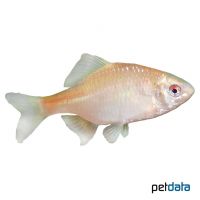European Bitterling Gold (Rhodeus amarus 'Gold')
| European Bitterling Gold Rhodeus amarus 'Gold' | |
|---|---|
| Name | European Bitterling Gold |
| Name Lat. | Rhodeus amarus 'Gold' |
| Synonym | Rhodeus sericeus amarus |
| Family | Bitterlings |
| Family lat. | Acheilognathidae |
| Order | Carps |
| Order lat. | Cypriniformes |
| Origin | Europe |
| Habitat | Rivers, oxbow lakes |
| Diet | Omnivore |
| pH | 6.5-7.5 |
| Behavior | Peaceful |
| Keeping | Group |
| Care Level | Easy |
| Reproduction | Swan Mussels |
| Breeding | Moderately difficult |
| Life Span | 3-5 years |
| Protection | No |
| Metric Units | |
| Size | 6-9 cm |
| Temperature | 4-24 °C |
| Hardness | < 15 °dH |
| Aquarium | ~ 200 l or ponds |
| US Units | |
| Size | 2.5"-3.5" |
| Temperature | 39-75 °F |
| Hardness | < 267 ppm |
| Aquarium | ~ 50 gal or ponds |
Distribution and habitat
The gold bitterling is a cultivated form. The distribution area of the Bitterling wild form extends from Western Europe, north of the Pyrenees and Alps to Eastern Europe. They are found in stagnant and slow-flowing waters, preferably in the plant-rich riparian zones with muddy bottoms. Pond or river mussels must also be present, which they require for reproduction.
Maintenance
The pond should be furnished with pond, floating and especially oxygenating underwater plants (milfoil, waterweed, hornwort, etc.), large river pebbles, and a substrate of sand and round-grained gravel, and provide plenty of free swimming space.
When maintaining in a cold water aquarium, make sure that there is plenty of swimming space in addition to dense perimeter planting and plenty of hiding places (roots, rocks). A soft substrate, oxygen-rich water and slightly shaded light (floating plants) is ideal
No ammonia, ammonium and nitrite should be detectable in the water, the nitrate value should not exceed 100 mg/l. To ensure the water quality and oxygen content should not be missing a filter adapted to the water volume.
Diet
They feed mainly on insects, small crustaceans and worms. The food supply consists of live or frozen cyclops, daphnia, tubifex and mosquito larvae or a frozen food mixture. High-quality pond food (granules, pellets, flakes) is also readily accepted. In addition, plant-based dry food (kelp, spirulina) should be fed occasionally.
Behaviour and compatibility
They are lively and sociable fish that do not show any aggressive or incompatible behavior. At least 5, but preferably more bitterlings should be kept together with pond or river mussels
In principle, only mutually compatible fish species with similar requirements for water quality and water temperature should be socialized.
Reproduction and breeding
In males, the upper half of the iris is red. The males are more intensely colored at spawning time and and have a reddish throat, chest and abdomen.
The spawning season is from April to June. They can only reproduce if a pond or river mussel is present. The female forms a 3-4 cm long thin-skinned ovipositor, which she inserts into the breathing hole of the mussel and deposits several eggs at a time in the gill cavity. At the same time, the male releases sperm that fertilizes the eggs in the gill chamber via the breathing water of the mussel. The spawning process is repeated several times. Protected inside the mussel, young fish develop and leave the mussel after 2-3 weeks with a size of about 1 cm.
Important
If they are overwintered in the pond, ensure sufficient depth and oxygen supply (filter, oxygen dispenser, ice free holder)
At temperatures below 8-10 °C the metabolism of the fish slows down and no more food is accepted, feeding must be stopped accordingly. If the temperature drops further, they hibernate near the bottom. In spring, with rising temperatures, feeding can slowly be resumed. Feeding may also be necessary during prolonged warm periods in winter.
The well-being of the fish should be monitored regularly. A regular partial water change, according to the pond size is recommended, even if the pollutant load has not yet reached the upper limit. Sudden changes in water quality should be avoided. Newly introduced fish must be accustomed slowly to the water in the pond or aquarium
Further literature can be found in your pet store.
References
Text: petdata; Image: petdata
Source: BMELV (1998): Tierschutzgutachten - Haltung von Zierfischen (Süßwasser); RIEHL & BAENSCH (2006): Aquarien Atlas Bd. 1, Mergus Verlag; ENGELMANN (2005): Zootierhaltung - Tiere in menschlicher Obhut: Fische; Harri Deutsch Verlag
- Gemäß § 21 Abs. 5 Tierschutzgesetz idgF
